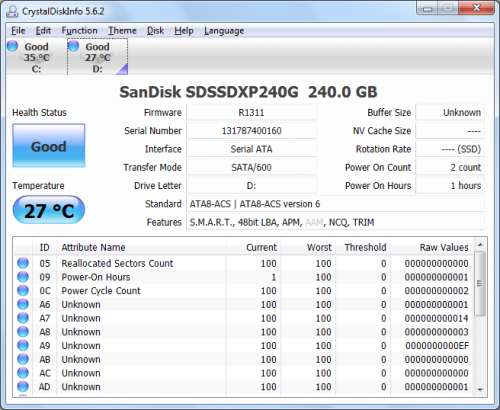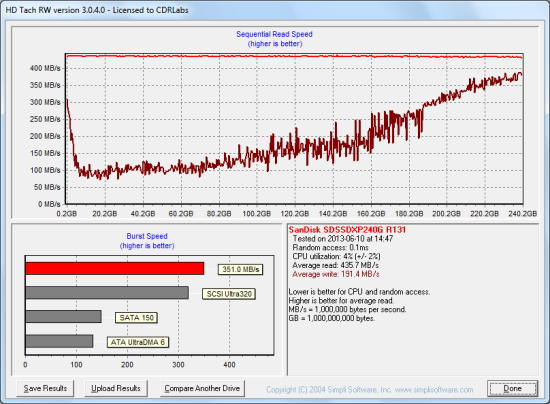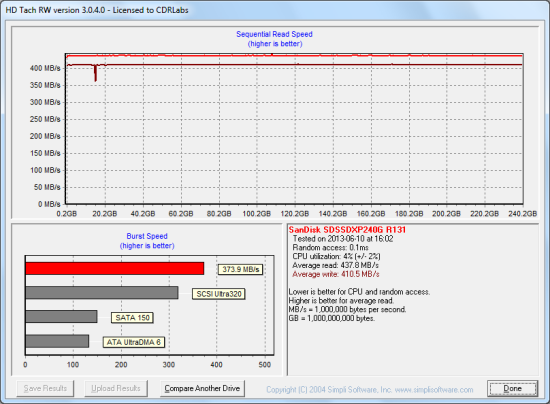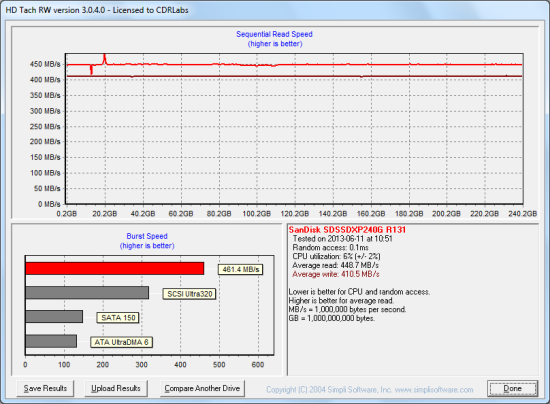TRIM Performance:
While SSDs offer many benefits, there are some downsides to using flash memory. One of the biggest issues people run into is performance degradation. Over time, an SSD will run out of fresh blocks and will have to write over data the file system has marked as deleted. This procedure is very complicated and can slow an SSD's write speeds considerably.
To address this problem, most manufacturers have added TRIM support to their SSDs. The TRIM command allows an operating system, such as Windows 7, to tell an SSD which data blocks are no longer in use. Using this information, the drive pro-actively erases these blocks and adds them to the free block pool.

To test the Extreme II's TRIM function, I first put the drive in a "dirty" state. I used Iometer to fill the entire drive and then ran a random write test for 30 minutes. This had very little effect on the Extreme II's read speed. However, its average write speed dropped to 191.4 MB/s.

SanDisk Extreme II SSD - Dirty
To see how well the Extreme II could recover, I let the computer sit for a little more than an hour and then reran the test. The drive wasn't able to reach the factory fresh performance shown in our earlier tests. However, its average write speed climbed up to 410.5 MB/s.

SanDisk Extreme II SSD - After Trim
Lastly, I used Parted Magic to perform a secure erase on the Extreme II. With the drive wiped clean, it had average read and write speeds of 448.7 MB/s and 410.5 MB/s, respectively.

SanDisk Extreme II SSD - Secure Erase
Final Thoughts:
The Extreme II is SanDisk's fastest and most innovative SSD to date. Designed with gamers and enthusiasts in mind, this ultra-slim drive combines Marvell's 88SS9187 controller with SanDisk's own 19nm eX2 ABL MLC Toggle NAND flash to deliver a reliable and responsive computing experience. In our sequential read and write tests, the Extreme II was able to read at speeds as high as 557 MB/s and write at speeds in excess of 480 MB/s. Thanks to SanDisk's tiered caching system, it also did pretty well in our random write tests, producing more than 65,000 IOPS at low queue depths. Moreover, it performed equally well with compressible and incompressible data and was able to sustain these speeds, even after intensive use.
The SanDisk Extreme II is available now in 120GB, 240GB and 480GB capacities. Prices on Amazon.com currently range from $130 up to $450, with the 240GB version reviewed here going for about $230.

Highs:
- Available in 120GB, 240GB and 480GB capacities
- Marvell 88SS9187 controller
- nCache Technology
- Excellent sequential read and write speeds
- Good random read and write performance
- Performs equally well with compressible and incompressible data
- Consistent performance, even after intensive usage
- SATA 6Gb/s interface
- Toggle Mode NAND flash
- Large DRAM cache
- Supports TRIM, garbage collection and wear leveling
- Ultra-slim form factor
- 5 year warranty
Lows:
- Does not support hardware based encryption
- Pricey

